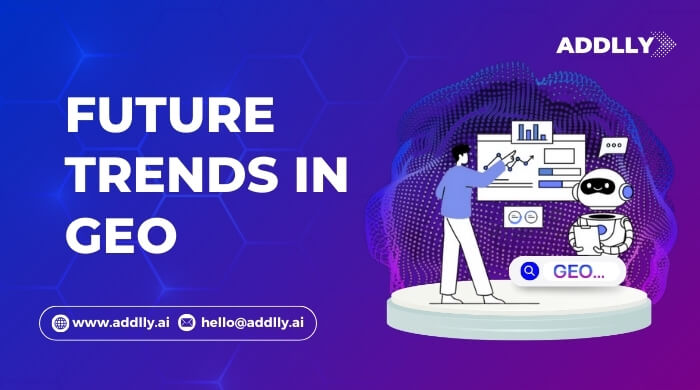Generative Engine Optimization focuses on optimizing for AI search engines and AI-driven platforms rather than traditional search engines alone. Instead of ranking pages in search engine results pages (SERPs), GEO emphasizes delivering content that AI models can understand, contextualize, and generate responses from.
To succeed in GEO, content teams and SEO professionals need to:
- Structure content with schema markup
- Create original content backed by reputable sources
- Anticipate conversational queries and user intent
- Support AI-generated summaries with authoritative and fresh data
- Avoid keyword stuffing in favor of natural, intent-driven language
GEO represents a shift from visibility in search results to visibility in AI-generated answers.
Quick Summary – Future Trends in GEO
Generative Engine Optimization (GEO) is rapidly becoming a core part of SEO as AI search engines shift focus from keywords and rankings to intent, context, and structured data. Staying visible will require SEO professionals to anticipate emerging trends and adapt strategies for AI-driven search.
- GEO at the Forefront: GEO is reshaping SEO by aligning content with AI-powered search behavior.
- AI Search Engines: These systems rely on natural language, user intent, and structured data for relevance.
- Emerging Trends: Real-time geospatial data, semantic search, generative AI, and predictive models are shaping the future.
- Zero-Click Experiences: AI-generated summaries and direct answers reduce clicks but boost brand exposure.
- Content Essentials: Fresh, authoritative, and multi-format content is critical for long-term visibility.
Key Trends Shaping the Future of GEO
The rise of AI-powered search is tied to broader technological advancements in AI platforms, natural language processing, and user behavior analysis. Below are the most important trends defining the future of GEO.
1. AI Search Engines Taking the Lead
AI search engines are steadily becoming the default search option. Unlike traditional search engines that crawl and index web pages, AI-powered search relies on large language models, retrieval-augmented generation, and vector search to determine relevance. Instead of showing a ranked list of results, AI models deliver direct responses in a conversational way.
This fundamental shift means SEO professionals must optimize for inclusion in AI-generated responses, not just rankings in Google search.
Read our guide on: How AI Search Engines Decide Which Brands Get Seen
2. Real-Time Geospatial Data in Search
Real-time geospatial and spatial data will play an increasingly important role. AI systems are capable of processing vast geospatial technology datasets, enabling them to deliver localized, relevant results in real time. Applications include environmental monitoring, logistics, transportation, and smarter cities.
SEO strategies will need to adapt by embedding location-rich structured data, ensuring businesses stay visible in geographically relevant queries and localized AI-generated summaries.
3. Semantic Search and User Intent
Semantic search allows AI-driven search engines to understand the meaning behind user queries rather than matching exact words. With AI algorithms interpreting context, user behavior, and preferences, the focus shifts from keywords to intent-driven content.
For SEO professionals, this means creating:
- Content written in natural language
- Pages that answer conversational queries
- Contextual connections between topics for better AI understanding
Semantic search demands a deeper content strategy that aligns with how users interact with search.
4. Voice Search and Conversational Answers
The rise of voice assistants and smart devices has led to an explosion in voice search queries. Generative AI models excel at delivering direct answers in a conversational format, making GEO strategies even more critical.
Optimizing for voice search requires:
- Targeting long-tail and conversational keywords
- Structuring FAQs and Q&A content for direct answers
- Ensuring natural flow in written content to align with spoken queries
5. Generative AI and Search Results
Generative AI is changing how search results are presented. AI-generated overviews, summaries, and instant answers mean users often receive information without needing to click through to a website, the rise of zero-click searches.
Although this reduces referral traffic, it creates opportunities for brands to gain exposure by being cited in AI-generated summaries. GEO strategies must focus on producing authoritative, well-sourced content that AI models trust.
6. Content Freshness and Real-Time Insights
AI-powered systems rely heavily on up-to-date information to provide accurate answers. Content freshness is no longer optional, it’s a ranking and inclusion factor for AI-driven search.
Strategies include:
- Updating evergreen content with the latest data
- Creating real-time insights based on current events and trends
- Regularly auditing and refreshing content libraries to maintain relevance
Fresh content signals reliability and helps brands stay visible in fast-changing search environments.
Read our blog on: Can AI Content Rank on Google
7. Structured Data and Schema Markup
Structured data and schema markup provide search engines and AI systems with clear context about content. GEO strategies must leverage schema markup to:
- Encode relationships between entities
- Highlight key attributes like reviews, FAQs, or local details
- Make content machine-readable and AI-friendly
Schema is increasingly becoming the bridge between human language and AI interpretation.
8. Content Formats Beyond Text
The digital ecosystem is no longer text-only. AI search engines process images, videos, podcasts, and even interactive experiences like digital twins. Content optimization must extend to multiple formats:
- Adding descriptive alt text for images
- Optimizing metadata for videos
- Structuring transcripts for audio and podcasts
By diversifying formats, brands strengthen visibility across all AI-driven responses.
Check our blog on: Types of Tones in Writing
9. Authoritative Sources and E-E-A-T
E-E-A-T (Experience, Expertise, Authoritativeness, Trustworthiness) continues to be a cornerstone of search visibility. AI search engines rely on authoritative sources when generating answers. GEO strategies must emphasize:
- Building digital PR and securing media mentions
- Creating content authored by recognized experts
- Citing reputable sources to reinforce trustworthiness
Authoritative content is more likely to surface in AI-generated overviews.
10. Internal Linking and Content Structure
Internal linking remains a powerful yet underutilized strategy in GEO. Well-structured internal links help AI models understand context, relationships, and hierarchy within a website. Content teams should:
- Use contextual anchor text
- Connect related pages and topics
- Maintain logical content hierarchies
These practices improve both traditional SEO and GEO visibility.
11. Zero-Click Searches as the New Normal
AI-driven search is pushing the industry toward zero-click experiences. Instead of driving traffic, AI systems deliver answers directly on the search interface. While this limits direct conversions, visibility remains crucial. GEO strategies must ensure that content is cited as the source of truth within AI-generated answers.
12. Predictive Models and User Behavior
Machine learning and predictive models allow AI systems to anticipate user needs before queries are fully formed. For SEO professionals, this means aligning content strategies with predictive search behavior.
Predictive optimization involves:
- Understanding customer journeys
- Mapping content to future search intent
- Preparing content that anticipates emerging questions
This ensures brands stay ahead in the evolving AI-driven search landscape.
The Role of GEO in a Rapidly Changing Digital Ecosystem
As AI-driven search becomes mainstream, GEO plays a pivotal role in ensuring visibility. Unlike traditional SEO, GEO focuses on:
- Supporting AI-generated answers with structured, trustworthy data
- Delivering context-rich, multi-format content for generative engines
- Adapting quickly to technological advancements in AI search tools
The rapid rise of AI platforms and algorithms means SEO professionals must pivot toward GEO to remain competitive.
How to Future-Proof Your GEO Strategy
To prepare for the future of Generative Engine Optimization (GEO), SEO professionals should adopt a multi-layered approach that goes beyond traditional best practices. GEO requires agility, adaptability, and a deeper alignment with how AI-driven search engines process and deliver information. Below are the key steps to keep your brand ahead:
Integrate Schema Markup to Provide Structure and Context
Schema markup remains one of the most powerful tools to help AI-driven search engines understand your website’s content. While traditional search engines rely on structured data for rich snippets, AI search engines go further, using schema to establish context and relationships between entities. Adding schema for products, FAQs, reviews, and business details can improve the way your content is interpreted and pulled into AI overviews or conversational responses.
Update Content Regularly to Ensure Freshness and Real-Time Accuracy
AI systems thrive on up-to-date information. If your content is outdated, it risks being overlooked in favor of fresher sources. Consistently refreshing blogs, landing pages, and resources helps maintain relevance. Beyond simply updating dates, this means weaving in new data, statistics, and industry insights that show your expertise and authority.
Optimize for Conversational Queries to Capture Voice and Natural Language Searches
Search behavior is shifting toward conversational queries. Users don’t just type “best running shoes”, they ask, “What are the best running shoes for flat feet in 2025?” Optimizing for natural language and long-tail queries increases the chance of your content surfacing in AI-powered summaries and voice search results. Think FAQ-style sections, question-based headers, and content that mirrors how people actually talk.
Diversify Content Formats with Video, Images, and Podcasts
AI search engines don’t only crawl text, they interpret multiple content formats. Videos, infographics, podcasts, and even short-form content like reels or stories can influence search visibility. A diversified content strategy not only improves brand presence but also caters to different user preferences. For GEO, these assets increase the chances of your content being referenced in AI-generated responses.
Strengthen Off-Page SEO Through Digital PR, Backlinks, and Media Mentions
Backlinks remain essential, but in the GEO era, digital PR and brand mentions take on greater importance. AI models consider authority and reputation when generating responses. Securing mentions in reputable sources, building relationships with media outlets, and earning editorial backlinks reinforce credibility. This boosts both E-E-A-T (Experience, Expertise, Authoritativeness, Trustworthiness) and visibility in AI search results.
Leverage Analytics and AI Tools for Real-Time Insights into User Behavior
The speed of AI-driven search evolution means SEO professionals can’t rely solely on historical data. AI-powered analytics tools provide real-time insights into user behavior, preferences, and intent. Monitoring search queries, user journeys, and conversion paths allows you to adjust your GEO strategy dynamically. Predictive models can also help anticipate emerging trends before competitors do.
Monitor AI-Driven Features in Search Engines to Adapt Strategies Early
Search platforms are constantly rolling out AI-driven features, from Google’s AI overviews to experimental AI assistants like Perplexity AI. Keeping a close eye on these changes is critical. Early adopters can adapt content strategies faster, ensuring their pages remain visible in zero-click searches and AI-generated summaries. This proactive approach helps maintain long-term visibility as the digital ecosystem continues to evolve.
FAQs – Future Trends in GEO
What Is The Difference Between GEO And Traditional SEO?
Traditional SEO focuses on ranking in SERPs, while GEO optimizes for inclusion in AI-generated answers, summaries, and overviews.
Why is Structured Data Important for GEO?
Structured data provides context that AI systems rely on to determine relevance, relationships, and authority.
Will Zero-click Searches Reduce Website Traffic?
Yes, but they also present opportunities for visibility. Being included in AI-generated responses enhances brand perception and credibility.
How Does Voice Search Affect GEO?
Voice search prioritizes conversational answers. GEO strategies should optimize for natural, spoken language queries.
Which Industries Benefit Most from GEO?
Industries reliant on real-time data, such as healthcare, logistics, environmental monitoring, and local businesses, benefit the most.
How Does GEO Connect with E-E-A-T?
Generative engines rely on authoritative, trustworthy sources. GEO strategies that emphasize E-E-A-T have a higher chance of surfacing in AI-driven responses.
Does GEO Replace Traditional SEO?
No. GEO builds on SEO by adapting to the needs of AI-driven search. Both approaches work together to maximize visibility.
What Role Does Content Freshness Play in GEO?
AI models rely on up-to-date information to generate accurate answers. Freshness signals trustworthiness and relevance, making regular updates essential.
What are the Main Challenges of GEO?
The biggest challenges include zero-click searches reducing traffic, the need for continuous content updates, and staying ahead of rapidly evolving AI search features.

